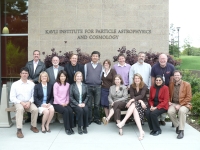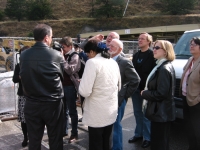 |
 |
|||||||||||||
|
|||||||||||||
|
|||||||||||||
|
Interactions members now officially classify as a tribe: flocking round the warming fire against the Californian chill they shared a goat during their meeting at SLAC last week. But though food may be memorable during the meetings of the InterAction collaboration, discussions and strategic plans are even more important for the communication representatives of particle physics labs, universities and projects. LHC start-up, the future of ILC communication and the meaning of blogs were just a few of the topics on the agenda of the three-day meeting that brought together 16 core and about 10 extended members of the InterAction family. They welcomed two new faces: Rika Takahashi, who has just taken up her job as ILC communicator for Asia at KEK, and Romeo Bassoli from INFN. While this last InterAction meeting at SLAC focused primarily on the LHC start-up, the ILC always plays a prominent role on the agenda, and in the past, full InterAction meetings have been dedicated solely to just the ILC. In fact, the concept of having dedicated ILC communicators in each region of the world is an outcome of the InterAction collaboration. During the meeting at SLAC, the ILC communicators reported on the press conference and media frenzy following the release of the Reference Design Report in February. Members of the collaboration specifically wanted to hear about the political response in the various regions and offered advice for preparing the final version of the ILC companion document to the RDR, which will be released in August. Almost serving as an advisory board to the ILC communicators, the InterAction collaboration offers invaluable advice and experience for developing and implementing a strategic communications plan for the ILC. Recently, the InterAction collaboration has been essential for coordinating worldwide communications for the LHC. The start-up of the LHC is a major concern for communications. The problem is not getting the media interested in the topic - the CERN press office under James Gillies already deals with more media requests than they can officially handle. It is much harder to define what start-up actually means. Is it the first stable beams around the ring? First beams at a certain energy? First collisions? When should there be a press release and a start-up media event, and how predictable is the day of this event? And, most importantly, how do we explain to camera crews that there will be no big red button to push? InterAction members all chimed in and will develop a well rounded press strategy with the CERN press office. The InterAction collaboration exists to support and communicate particle physics around the world and to set a good example of peaceful collaboration across borders. The past few weeks demonstrated that it works. A major problem with a magnet a few months before a major particle accelerator is due to start officially classifies as a 'rough time' in the physics world. A Fermilab-built LHC magnet had failed a pressure test, threatening the project's schedule. In an immediate coordinated effort stretching three continents CERN and Fermilab published the news on their websites simultaneously and handled questions together. “It is great to see that we can really rely on each other,” said Judy Jackson, Director of Communications at Fermilab. On the first day of the meeting, participants presented SLAC Director Jonathan Dorfan with a special plaque thanking him for his extraordinary contribution to worldwide particle physics communication. “Jonathan played an enormous role in the creation of interactions,” said Judy Jackson. “Without his constant support we wouldn't be where we are today.” The collaboration also got a tour of the campus by SLAC's Communications Director Neil Calder. Visiting the Stanford Synchrotron Radiation Laboratory, the accelerator complex and BaBar experiment and construction sites for the new LCLS, the InterAction members weren't idle: with similar sights and problems around all labs some of them are thinking of initiating a communications-driven safety campaign. The next meeting is planned for autumn in Europe. -- Barbara Warmbein |
|||||||||||||
| © International Linear Collider |

